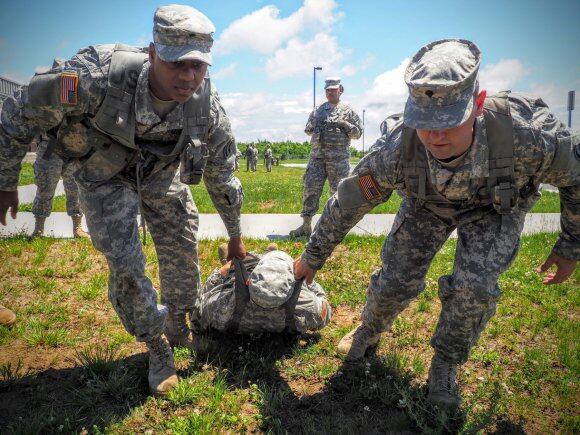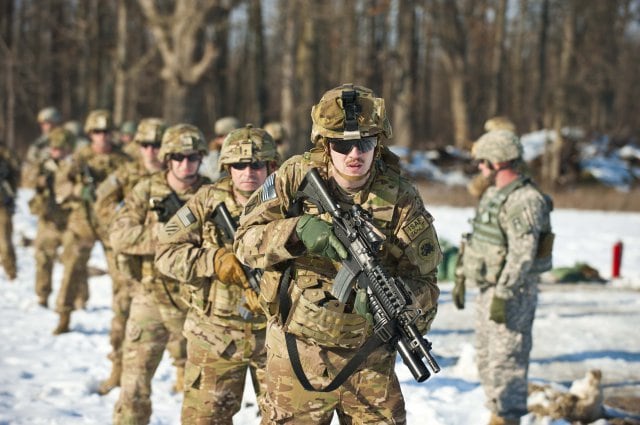The Army is launching a pilot program this summer that pairs active-duty units with those in the Army Reserve and Army National Guard so they can train together and even deploy together.
The Associated Units pilot will establish formal relationships between the units, officials announced Tuesday. It also will mean more training days each year for the Guard and Reserve units involved.
"Much of America's Army's capacity is resident in the reserve components, and we must rely more heavily on them to meet the demands of a complex global environment," Army Chief of Staff Gen. Mark Milley said in a statement. "The Associated Units pilot allows us to leverage the capabilities and capacities of the active component, Army Reserve and Army National Guard as one Army."
The first units to be paired together are Task Force 1-28 Infantry, an infantry battalion stationed at Fort Benning, Georgia, and the Georgia National Guard's 48th Infantry Brigade Combat Team. The brigade also will be associated with the active Army's 3rd Infantry Division at Fort Stewart, Georgia.
The goal of these partnerships is to establish relationships between the units prior to mobilization, said Troy Rolan, an Army spokesman.
"[This] requires training together as much as possible, both at home station and at combat training centers," he said. "The units will wear common patches and will exchange personnel to enhance the integration."
In the case of this first partnership, soldiers from Task Force 1-28 and the 48th BCT will wear the patch of the 3rd Infantry Division, Lt. Gen. Timothy Kadavy, director of the Army Guard, said in a statement.
"This brigade will train, and, if called to do so, deploy and fight with the 3rd Infantry Division as an Associated Unit," Kadavy said. "These units will develop relationships and standards in home station so they may fight together in combat without having to meet on the battlefield and figure these things out."
Milley — both as the chief of staff and in his previous assignment as commander of U.S. Army Forces Command — has emphasized the importance of all three Army components.
In January, he said the Army is working to rely more heavily on the Guard and Reserve and was looking for ways to increase partnerships between the components and add more combat training center rotations for Guard brigades. The U.S. cannot go to war without the Guard or Reserve, Milley said at the time.
"War consumes a lot of assets … and you just can't get there without the strategic depth that's necessary and provided by the Guard and Reserve," he said. "War is a national challenges, and, for our part, we cannot execute without the Guard and the Reserve."

The Army's Associated Units pilot program pairs active-duty units with Army National Guard and Army Reserve partners. Here, New York Army National Guard Specialists Kadeem Fowler and Richard Madsen, both members of the 42nd Infantry Division, practice combat lifesaver techniques during annual training.
Photo Credit: Sgt. J.P. Lawrence/Army
The Associated Units pilot will begin in June, and current plans call for the Army to test the concept for three years and transition to full implementation in 2019, Rolan said.
"The Army will conduct periodic reviews during execution and could accelerate or slow down implementation based on what is learned," Rolan said. "A critical element of the pilot is repetitive collective training and combat training center rotations, which drives the need for a multi-year test."
The Associated Units pilot is similar to a program launched in summer 2014 by U.S. Army Forces Command.
FORSCOM's Total Force Partnership Program paired active-duty units with those in the Army Guard to create partnerships, increase training opportunities at home and boost leader development. The paired units included brigade combat teams, aviation brigades and fires brigades.
The Associated Units pilot will not replace or preclude FORSCOM's partnership efforts, Rolan said.
Instead, it "takes selected partnerships a step farther by adding training and readiness authorities and responsibilities and prioritizing resources," he said.
As the pilot unfolds, more units will be paired together this summer.
There will be about two dozen units in the initial group, including infantry, engineer and sustainment units, Rolan said.
In addition, Guard and Reserve units included in the pilot will conduct up to 15 additional days of training each year, he said.
"The goal is not to achieve the same readiness as an [active component] unit, but rather to sustain higher readiness to reduce post-mobilization training requirements when activated," he said.
At the end of the pilot, the concept could expand to include other types of units, such as field artillery, military police or intelligence. However, "full implementation will likely target key formations and enabling capabilities where senior leaders want to prioritize readiness and responsiveness," Rolan said. "Resourcing the strategy's training requirements, which includes additional training days for reserve component units, is not feasible for every unit in the Army."

The Army's Associated Units pilot program pairs active-duty units with Army National Guard and Army Reserve units for training and possible deployment. Here, soldiers from the Georgia Guard's 201st Regional Support Group conduct reflexive fire training at Camp Atterbury Joint Maneuver Training Center, Ind.
Photo Credit: Staff Sgt. Reginald Graddy/Army
The units kicking off the pilot are:
• The 1st Battalion, 143rd Infantry Regiment from the Texas Army National Guard will be associated with the 173rd Airborne Brigade Combat Team in Vicenza, Italy.
• The 1st Battalion, 151st Infantry Regiment from the Indiana Guard will be associated with 2nd BCT, 25th Infantry Division at Schofield Barracks, Hawaii.
• The Army Reserve's 100th Battalion, 442nd Infantry Regiment in Hawaii will be associated with 3rd BCT, 25th Infantry Division at Schofield Barracks.
• The 81st Armored Brigade Combat Team from the Washington Guard will be associated with the 7th Infantry Division at Joint Base Lewis-McChord, Washington.
• The 3rd BCT, 10th Mountain Division at Fort Polk, Louisiana, will be associated with the Texas Guard's 36th Infantry Division.
• The 86th Infantry Brigade Combat Team from the Vermont Guard will be associated with the 10th Mountain Division at Fort Drum, New York.
• The Reserve's 824th Quartermaster Company in North Carolina will be associated with the 82nd Sustainment Brigade at Fort Bragg, North Carolina.
• The 249th Transportation Company from the Texas Guard and the 1245th Transportation Company from the Oklahoma Guard will be associated with the 1st Cavalry Division Sustainment Brigade at Fort Hood, Texas.
• The 840th Engineer Company from the Texas Guard will be associated with the 36th Engineer Brigade at Fort Hood.
• The 1176th Transportation Company from the Tennessee Guard and the 2123rd Transportation Company from the Kentucky Guard will be associated with the 101st Sustainment Brigade at Fort Campbell, Kentucky.
• The 5th Engineer Battalion at Fort Leonard Wood, Missouri, will be associated with the 35th Engineer Brigade from the Missouri Guard.
Michelle Tan is the editor of Army Times and Air Force Times. She has covered the military for Military Times since 2005, and has embedded with U.S. troops in Iraq, Afghanistan, Kuwait, Haiti, Gabon and the Horn of Africa.





